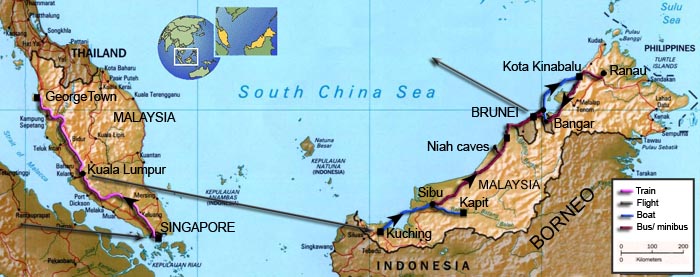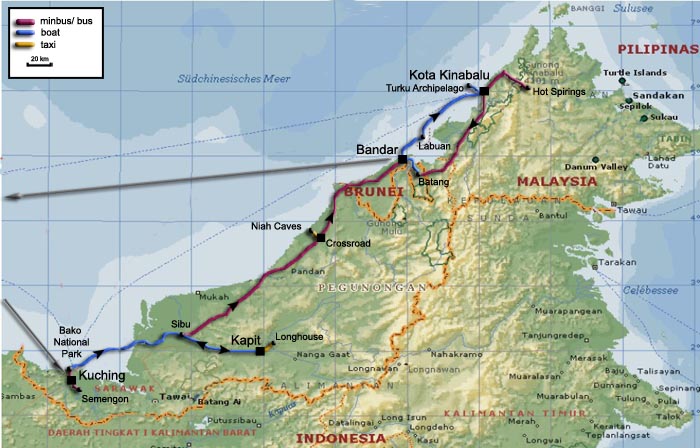Malaysia (Borneo)
 |
 |
Malaysia (Borneo)
13 days,
August '10
|
TRAVEL IN MALAYSIA
| Day | Transport | Duration | |
| 3 night | Singapore- Kuala L. | Train | 8h |
| 4 | Kuala L.- Butterworth | Bus | 7h |
| 4 | Butterworth- George T. | Boat | 30min |
| 5 | George T.- Butterworth | Boat | 30min |
| 5 night | Butterworth- Kuala L | Train | 8h |
| 6 | Kuala L.- Kuching | Flight | 1.5h |
| 7 | Kuching (Bako N.P.) | Bus + Boat + On foot | 1h + 1h + 3h |
| 9 | Kuching-Kapit | Boat | 7h |
| 10 | Kapit (longhouse) | Car (with driver) | full day |
| 11 | Kapit- Sibiu | Boat | 3h |
| 11 | Sibu- Niah caves | Bus | 6h |
| 12 | Niah caves- Bandar S. B. | Bus | 8h |
| 13 | Bandar S. B.- Kota K. | Boat | 5h |
| 14 | Kota K. (Turku Archipelago) | Boat | full day (1h by boat) |
| 15 | Kota K.(hot springs) | Minibus |
full day (3h by minibus) |
| 16 | Kota K. (Turku Archipelago) | Boat | full day (1h by boat) |
| 17 | Kota K.- Bandar S.B. | Bus + Boat | 3h +2h |
Continental Malaysia
A night train led us in 8h from Singapore to Kuala Lumpur;
in the Malaysian Capital we jumped on a bus towards the well-known
Penang Island. After 7h we pulled in Butterworth (the mainland
town in front of the island) where we got the hourly ferry for
the 20min sea cross.
Georgetown is the capital of the Penang region (the whole region
is the island) and by consequence the main town of the island.
Here we settled in the 'Love In' guesthouse paying 13ˆ
for a double with A/C (forget sleeping without!) The island
is an easy destination for backpackers abounding of cheap guesthouses
and highlights convenient for day trips by public transports.
The following day we took a bus to the snake temple (1h). The
name will stimulate your curiosity (as did for ours), but don't
expect too much; the few snakes sliding around are quite sleepy,
and the stalls outside give the impression it's more a tourist
draw.
Then by a 20 taxi ride we reached the Kek Lok Si temple, the
Malaysia biggest Buddhist temple, being definitely worth the
trip. Besides of his vastness and the variety of colours, it's
the location making the real highlight: the temple is set along
a steep slope (there's even the funicular to climb it up) and
at the top dominated by a 30m high statue of Goddess of mercy.
In the late afternoon by bus (2h) we reached the Batu Ferringhi
beach. Don't expect a tropical paradise just for yourself: this
is the main destination for the Arab couples honeymoons and
the amount of activities (water scooter, jet parachuting …)
make the place quite busy and as woman you could feel not at
ease wearing a swimming suit.
The same night we got the train at 23.00 getting off in Kuala
Lumpur at 7.30am, where we directly went to the Batu Caves,
the most popular Hindu shrines outside India. It's a series
of chambers, where temples are built inside. Despite being the
most visited highlight of the country, the authentic atmosphere
and the scenic setting of the limestone rocks make the visit
a must.
BORNEO (Sarawak)
A quick flight (1.5h for 90euro) led us to Kuching, the southernmost
town of the Sarawak region of the Malaysian part of the Borneo
island.
The town, characterised by a promenade along the river, is for
sure the most pleasant one we visited in the whole Borneo. Unfortunately
the same cannot be said for the guesthouse (Mr'D), where the
room (14euro with A/C) was really too tiny to move in and the
guys at the reception a kind of stoned.
We spent the whole next day at the Bako National Park: from
Kuching at 8.00am there's a bus (1h) dropping you off at the
harbour, where you have to rent a boat (60ˆ for 5 people
back and forth) to reach in 45min the entrance of the park (read
the
tips)
Here we began a circle itinerary (6km in 6h) reaching a paradise-like
beach, where we had a swim. It's a real sweating jungle walk,
but honestly we got disappointed by not seeing an animal beside
few mosquitoes and a butterfly. Anyway it's worthwhile and I
would recommend, but don't expect it's like visiting a zoo.
The day after we visited the Orang-utan reserve: if you want
to attend the morning feeding at 9.00, don't miss the 7.20 am
bus as we did (we took a taxi). Don't expect to be alone during
the feeding but chances to see Orang-utans are quite high and
not through the bars of a cage.
The third day we set out to Kapit through a long 6h boat journey
(stopping over in Sibu), however so scenic to the extent of
being the highlight of the whole travel. The boat has comfortable
airplane-like seats, but the freezing A/C will make you prone
to enjoy the boat roof as we did. After few hours in the open
sea, the boat sails upstream the Kajang river. The trip pace
is interrupted by the frequent stopovers to supply the villages
being the river their only communication: further it gets from
Sibu, more the river narrows down and you feel to enter the
in the jungle, despite logging has already played its part.
In the small town of Kapit itself there's not much to see, beside
a market, a 19th century English fort and a museum, but I liked
the feeling of being in a 'relatively' remote place connected
to the rest of the world by a river on the way to the heart
of Borneo
Having said this it's a convenient base to visit the typical
long-houses of Borneo, namely a cluster of houses joined by
a long common area, where the whole communities live together
in daytime.
Don't expect travel agencies to organize you trips, you will
have to find you contact,
As suggested by the research done in the net we called Cristine
from Greenland hotel asking for a guided full day by car. Frankly
I found 70€ quite expensive but no big other choices though
and at the end it turned out a very interesting experience we
couldn't have done by ourselves.
At first we went to a poor longhouse, staying one hour inside
one of the houses and visiting the school. Then after 1h driving
we crossed the river to a wealthier village.
Here we saw the village life, even visiting the surprising modern
clinic, proud of showing us 6 baby had already been delivered
that year.
Our plan was to proceed to Belaga through the Rajanga River
and then by jeep reaching the coast.
Unfortunately as typically can happen in the dry season (August),
that day the boat didn't run to Belaga due to the water level
too low to pass the rapids.
Quite depressed we came back to Sibu jumping on the bus on the
way to the Niah Caves. The bus dropped us at the cross road
in the darkness 13 km from the Caves, where luckily there was
a restaurant and a motel!!
The following morning we took a taxi to the entrance of the
Park, from where we walked 1h over a wooden pathway through
the forest, nice stroll but again no animals.
The Caves are impressing and their magnitude in term of impressiveness
is overtaken only by the smell of 500.000 bat's guano. What
makes the visit an adventure is the 1km pathway in the darkness
guided only by your flash lamp (you can rent one at the entrance).
Then we took again a taxi to the cross road, where we waited
a bus to Miri and finally another one to Bandar Seri Begawan
the capital of Brunei (6h by bus from Miri).
BORNEO (Sabah)
Kota Kinabalu is much more touristy than Kuching, being in front
of Tunku Abdul Marine Park archipelago. Here there's no lack
of guesthouses, but we struggled to find a room available.
The archipelago is ideal for daytrips from KK (no other choice
though) roughly 40min by boat, but at a cost.(read the
tips) There'r five island where you can snorkel, having
tan,… don't expect to be the only one on the island, since
you'll have plenty of Japanese neighbors'.
One of the three days we spent in KK we visited the poring hot
springs 3hours by minibus. The site itself built by Japanese
during WWII occupation has an artificial look, at least the
short canopy walk, built at the top of the trees, allows an
unusual 'monkey point of view' of the jungle. Anyway what makes
the trip interesting is definitely the landscape so different
from the coast. In fact on the way to the site the minibus will
climb up to the green mountains wrapped in the fog.
If you are not prone to vertigo there a short canopy walk over
the jungle.
The following day we headed to Brunei: initially I hoped to
get the train but it's still under renovation (it could be open
when you read). Instead of taking the early morning direct bus
we wanted to break the trip in Beafourt turning out to be an
error. In fact we found ourselves stranded in Lapas (20km from
the border) and we had to take a taxi to proceed towards Brunei.
Alby
Malaysia-Borneo travel tip
|
|
|
EU citienzens
don't need a visa, just your passport will be enough.
However take into consideration that:
The currency is the Malaysian Ringit (1€= 4.1 RM). You can change almost everywhere against € or $. Same currency in the whole Malaysia Borneo included.
I used the english
Lonely Planet 'Malaysia, Singapore and Brunei 2009
and the Rough Guide 'Malaysia, Singapore and Brunei'
6th edition , Sept2009.
I had the usual
vaccinations: ephatite A, B, typhus and tetanus. I
know your main concern is the dilemma 'to do or not
to do the antimalaric treatment?'
|